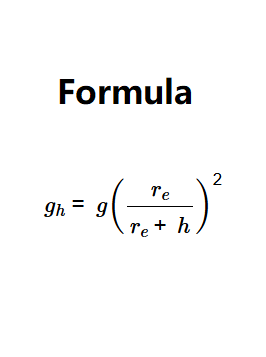 Home
Home
 Back
Back

Definition: This calculator computes the gravitational acceleration (\( g_h \)) at a given altitude (\( h \)) above sea level based on the inverse-square law of gravitation.
Purpose: It is used in physics and engineering to determine the variation of gravitational acceleration with altitude, applicable in satellite orbits, atmospheric studies, and geophysical modeling.
The calculator uses the relationship:
Where:
Explanation: Enter the altitude above sea level in the chosen units, and the calculator computes the gravitational acceleration. Results are displayed with 5 decimal places, using scientific notation if the value exceeds 100,000 or is less than 0.0001. For the default input (\( h = 1000 \, \text{m} \)), the calculated gravitational acceleration \( g_h \) is approximately 9.80366 m/s².
Details: Understanding how gravitational acceleration decreases with altitude is crucial for accurate calculations in aerospace, geophysics, and navigation systems, especially for objects at significant heights above the Earth's surface.
How do I find gravitational acceleration at altitude?
Measure the altitude above sea level in meters. Use the formula \( g_h = g \left( \frac{r_e}{r_e + h} \right)^2 \), where \( g \) is 9.80665 m/s² and \( r_e \) is 6,371,000 m. You will then have the gravitational acceleration in m/s².
How can I find altitude with gravitational acceleration?
Measure the gravitational acceleration at a specific height in m/s². Use the relationship \( g_h = g \left( \frac{r_e}{r_e + h} \right)^2 \) and solve for \( h \) by rearranging: \( h = r_e \left( \frac{g}{g_h} \right)^{1/2} - r_e \), where \( g \) is 9.80665 m/s² and \( r_e \) is 6,371,000 m.
What is the formula for gravitational acceleration at altitude?
The formula for gravitational acceleration at altitude is \( g_h = g \left( \frac{r_e}{r_e + h} \right)^2 \), where \( g_h \) is the acceleration at altitude, \( g \) is the sea-level gravitational acceleration (9.80665 m/s²), \( r_e \) is the Earth's radius (6,371,000 m), and \( h \) is the altitude above sea level. The standard unit is m/s².